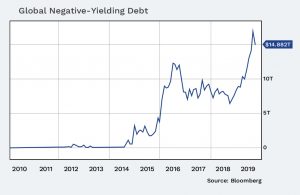Nelson Capital Management


At the start of 2019, the yield on the 10-year U.S. Treasury was 2.68% and the market was expecting the Federal Reserve to increase rates several times over the course of the year. Amid concerns over trade tensions with China and a global slowdown that could affect the U.S. economy, the Fed reversed course quickly and cut rates by 0.25% in July and in September to a range of 1.75% to 2.0%. The yield on the 10-year Treasury has fallen to 1.72% and the market does not believe the Fed is done cutting. There is now a debate about whether the U.S. will follow other countries and push rates into negative territory. How low can yields go? And what does negative-yielding debt mean?
 Approximately $15 trillion in overseas bonds currently trades with a negative yield. The Bank of Japan and European Central Bank cut short-term target rates to zero and then into negative territory to respond to global growth concerns and help stimulate their economies. The recent decline of longer rates has been unprecedented. In October, the entire German yield curve was negative.
Approximately $15 trillion in overseas bonds currently trades with a negative yield. The Bank of Japan and European Central Bank cut short-term target rates to zero and then into negative territory to respond to global growth concerns and help stimulate their economies. The recent decline of longer rates has been unprecedented. In October, the entire German yield curve was negative.
Negative-yielding bonds are not new, but why an individual investor would buy a bond with a negative yield is difficult to comprehend. For many large banks and pension plans, investment policies require portfolio managers to buy and hold minimum levels of highly-rated government bonds regardless of yield. In many of these cases, the managers of funds are buying negative-yielding bonds, but are generating positive returns through complex cross-currency basis swaps.
Could we see negative yields in the U.S.?
 We do not believe negative rates are on the horizon here in the U.S., but a severe recession that leads to deflation could force the Federal Reserve to follow the Bank of Japan and European Central Bank, something it has never done before. The Fed cut rates to zero in response to the 2008-2009 financial crisis, but never crossed below zero. President Trump recently voiced his opinion, stating that the Fed needed to cut rates to zero or below to keep the economy growing. Fed President Powell disagreed and said he did not foresee negative rates
We do not believe negative rates are on the horizon here in the U.S., but a severe recession that leads to deflation could force the Federal Reserve to follow the Bank of Japan and European Central Bank, something it has never done before. The Fed cut rates to zero in response to the 2008-2009 financial crisis, but never crossed below zero. President Trump recently voiced his opinion, stating that the Fed needed to cut rates to zero or below to keep the economy growing. Fed President Powell disagreed and said he did not foresee negative rates
The current low interest rate environment presents challenges to generating real yields and penalizes savers and those living off fixed income. In light of these low yields, we continue to recommend owning high-quality bonds in our portfolios for both diversification and as a hedge against a downturn in the stock market.
Individual investment positions detailed in this post should not be construed as a recommendation to purchase or sell the security. Past performance is not necessarily a guide to future performance. There are risks involved in investing, including possible loss of principal. This information is provided for informational purposes only and does not constitute a recommendation for any investment strategy, security or product described herein. Employees and/or owners of Nelson Roberts Investment Advisors, LLC may have a position securities mentioned in this post. Please contact us for a complete list of portfolio holdings. For additional information please contact us at 650-322-4000.
Receive our next post in your inbox.